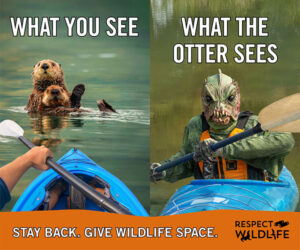
As many of us know from running environmental campaigns on social media: online platforms bring out the best in some and the worst in others. It can be disheartening to learn that not everyone is as supportive of clean water, wildlife, or air quality as we are. What seems a no-brainer to us, (do you actually WANT pollution in your water?), is anathema to others.
For some of us who monitor these online conversations, (and I include myself here) it may be hard to read and manage negative comments that target our work or the things we are trying to protect. Fortunately, my unflappable colleague at Gigantic, Nancy Roberts, coached me through this aspect of our work in our recent campaign for Respect Wildlife. In this blog, I’ll share what I learned from her “Keep Calm and Carry On” approach to social media management. You can view the campaign here.
Nancy’s Top 3 Social Media Comment Tips
1. Don’t take comments personally. If monitoring comments becomes mentally taxing, take breaks or assign the task to someone else.
2. Understand that comments are data points.
3. Establish a comment policy: Include how you will deal with profanity, bullying, slurs, violent language, or other troublesome content, and create a threshold for when you will hide or delete a comment. If you are a government agency, you may need to adhere to free speech regulations and let comments stand, more so than nonprofits or private businesses, which can set their own policies.
For Facebook: Hide rather than delete comments. This will prevent conflict.
For Instagram: You can’t hide comments; delete only if absolutely necessary.
For Twitter: You cannot hide replies; if they are truly egregious you can report to Twitter.
Decide how/if you want to respond to comments. In most cases we recommend no response unless there is significant misinformation. Let other commenters step in to present an alternative viewpoint or challenge the naysayers. This is more authentic.
Lessons Learned from Our Recent Respect Wildlife Campaign:
As mentioned above, comments are rich sources of feedback, even the negative ones. Here are some takeaways on the campaign that we and the client gained through comment feedback:
- Not everyone loves animals or cares if animals are hurt. (Especially seagulls!) Some people view humans at the top of food chain, and therefore it’s ok show dominance. While not the majority, this view is especially hard to deal with, but an important thing to remember. Appeals to protection, being a good person, etc. will not work for this type of individual.
- Regulations, even those meant to protect vulnerable species, are viewed by a vocal minority as government control and overreach, and inspire especially negative comments.
- Not everyone understands or supports a humorous approach. Many expressed enjoyment of the campaign’s exaggerated artwork style, but it inspired some very literal thinkers to call out the “falsehoods” shown in the memes. (We actually did know that otters don’t really see humans as swamp creatures!)
- If feeding or approaching wildlife is “fun” for humans and pets, it’s considered harmless.
Good luck on your next social media campaign! I hope you connect with supporters and learn from the detractors.

 Our team has gotten even more Gigantic! We are pleased to announce the addition of Myer Venzon and Dennis Uyat to our team of Associates.
Our team has gotten even more Gigantic! We are pleased to announce the addition of Myer Venzon and Dennis Uyat to our team of Associates. Dennis holds a B.A. in Geography with a minor in Geospatial Information Science Technology from UC Berkeley and an A.A. in Recycling and Resource Management from Golden West College in Huntington Beach. They hold a certificates in Master Resource & Conservation and Master Compost & Solid Waste from the San Mateo County Office of Sustainability, and Zero Waste Community Associate by Zero Waste USA.
Dennis holds a B.A. in Geography with a minor in Geospatial Information Science Technology from UC Berkeley and an A.A. in Recycling and Resource Management from Golden West College in Huntington Beach. They hold a certificates in Master Resource & Conservation and Master Compost & Solid Waste from the San Mateo County Office of Sustainability, and Zero Waste Community Associate by Zero Waste USA.




 One of the challenges of zero waste outreach is how to convince people to NOT do something: buy new stuff. Every day Americans are bombarded by thousands of slick, seductive ads encouraging the purchase of shiny new things that they may or may not need. Helping the public to understand that “Reduce, Reuse, Recycle” is a list in priority of importance is tricky. How can reducing consumption be positioned as a positive?
One of the challenges of zero waste outreach is how to convince people to NOT do something: buy new stuff. Every day Americans are bombarded by thousands of slick, seductive ads encouraging the purchase of shiny new things that they may or may not need. Helping the public to understand that “Reduce, Reuse, Recycle” is a list in priority of importance is tricky. How can reducing consumption be positioned as a positive?